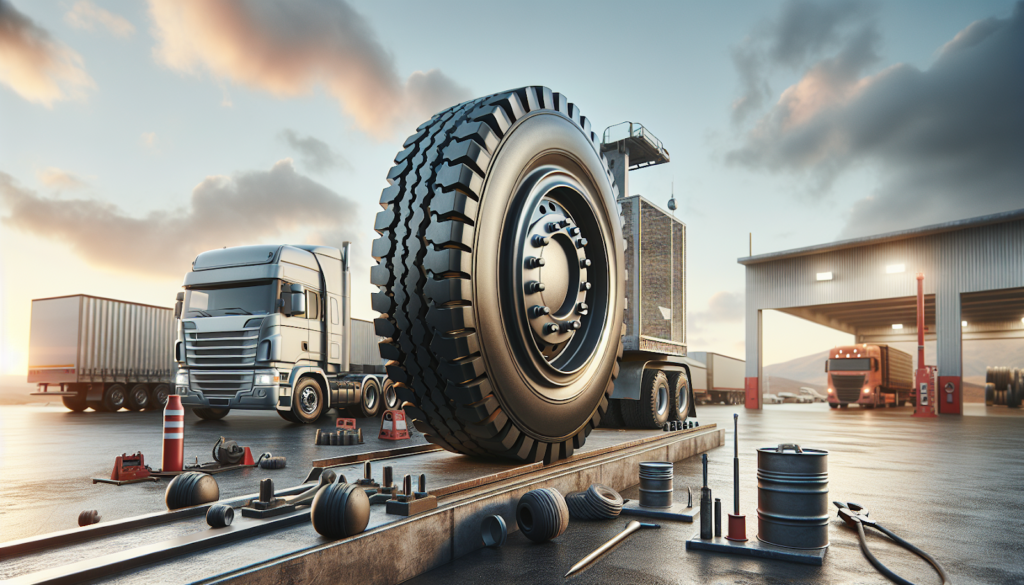Introduction to Run-Flat Tires
Definition and Overview of Run-Flat Technology
Run-flat tires represent a significant innovation in the automotive industry, designed to resist the effects of deflation when punctured. This technology allows a vehicle to continue to be driven at a reduced speed and for limited distances even after experiencing a tire puncture. Run-flat tires maintain their shape and offer support to the vehicle thanks to the reinforced sidewalls or internal support rings, which differ from the conventional tire construction. These unique features enable drivers to safely navigate to a repair shop or a safe location without immediately having to change the tire at the roadside.
The Importance of Run-Flat Tires in Modern Vehicles
The introduction of run-flat tires has become increasingly prominent in modern vehicles, providing an essential safety feature for drivers. These tires address the concern of being stranded on a busy road or in a hazardous situation due to a flat tire. Offering enhanced safety and convenience, run-flat tires ensure that losing tire pressure doesn’t necessarily result in immediate and unsafe roadside tire changes. Furthermore, they eliminate the need for spare tires, potentially reducing vehicle weight and increasing cargo space, which aligns with the modern emphasis on efficiency and design.
The Mechanics of Run-Flat Tires
Construction and Design Features
The design of run-flat tires primarily focuses on allowing a vehicle to continue operation despite air loss. This is achieved through reinforced sidewall construction or a support ring. Reinforced sidewalls are made of tough rubber compounds to bear the weight of the vehicle in case of a puncture. On the other hand, some run-flat designs utilize a support ring — a rigid ring attached to the wheel that supports the vehicle’s weight if the tire loses pressure. Both designs ensure that the tire doesn’t collapse or come off the rim, allowing the driver more control over the vehicle than they would have with a standard deflated tire.
How Run-Flat Tires Differ from Standard Tires
While standard tires rely on air pressure to maintain shape and carry the vehicle’s weight, run-flat tires are built to maintain their form and offer support even without air. This structural difference is critical for run-flat functionality. Standard tires are much more vulnerable to a blowout and can cause loss of vehicle control when punctured. Run-flat tires are constructed with thicker sidewalls that are capable of supporting the vehicle for a short distance, giving drivers the ability to reach a more convenient or safe destination for repairs.
Advantages of Run-Flat Tires
Safety Benefits During a Puncture
One of the most significant advantages of run-flat tires is the increased safety they provide during a puncture. When a traditional tire deflates rapidly, it can lead to a loss of control, resulting in potentially hazardous situations. With run-flat technology, drivers can maintain better control and steer their vehicle to safety after a puncture occurs. This safety feature is particularly valuable in adverse conditions, such as heavy traffic or poor weather, where an immediate stop might not be possible or safe.
Continuation of Journey After Tire Damage
Run-flat tires offer the convenience of allowing drivers to continue their journeys for a limited distance without having to immediately pull over and change the tire. Typically, a driver can go approximately 50 miles (80 kilometers) at a reduced speed after a puncture or severe tire damage. This provides enough range to exit a highway, find an auto service, or just reach home, which adds peace of mind and significant utility for daily drivers and long-distance travelers alike.
Disadvantages of Run-Flat Tires
Ride Quality and Comfort Considerations
Despite their advantages, run-flat tires do have some drawbacks, particularly regarding ride quality and comfort. The stiffer sidewall construction that enables a tire to continue running without air pressure also results in a firmer ride. This can make run-flat tires feel less comfortable on rough or uneven surfaces, as they may not absorb bumps and potholes as effectively as standard tires. For some motorists, the trade-off between the added safety of run-flats and the potentially harsher ride quality is a consideration when choosing tires for their vehicle.
Replacement Cost and Availability Issues
The cost of run-flat tires can be another disadvantage as they are typically more expensive than standard tires. The advanced technology and materials used in their construction contribute to the higher price point. Additionally, not all tire shops keep a wide selection of run-flat tires in stock, which may result in limited availability or delays in obtaining replacements when needed. When selecting run-flat tires, drivers should be aware of the potentially higher long-term costs for maintenance and replacement.
Brands and Types of Run-Flat Tires
Leading Manufacturers of Run-Flat Tires
Leading tire manufacturers such as Bridgestone, Michelin, Pirelli, and Goodyear offer various run-flat tire options. These companies have invested significantly in the development of run-flat technology and have created multiple product lines that incorporate these features. The innovations brought forward by these industry leaders demonstrate their commitment to enhancing driver safety and convenience through advanced tire technology.
Different Models and Their Specific Features
Each manufacturer has its take on run-flat technology, leading to a market rich with different models to choose from. For instance, Bridgestone’s DriveGuard tires are engineered to be as comfortable as traditional tires while offering the safety benefits of run-flats. Michelin’s Zero Pressure (ZP) tires use a patented sidewall reinforcement technology for robust performance after a puncture. Goodyear’s RunOnFlat, meanwhile, utilizes their proprietary Extended Mobility Technology to maintain operability after air loss. Though models vary in specific design and performance characteristics, all seek to provide the same core benefit: safety and control in the event of tire pressure loss.
Run-Flat Tire Performance and Maintenance
Handling and Driving with Run-Flat Tires
Run-flat tires can affect a vehicle’s handling characteristics due to their unique construction. Because they are designed to be driven even without air pressure, run-flats might show less sidewall flex compared to conventional tires, which can impact steering responsiveness and ride comfort. However, many manufacturers tune their run-flat tires to complement the handling dynamics of specific vehicle models, resulting in minimal difference during normal driving conditions. It’s essential to remember that run-flat tires should only be driven at reduced speeds and for a limited distance once they have lost pressure to ensure safety.
Maintenance Tips for Prolonging Tire Life
Regular maintenance is vital for prolonging the life of any tire, and run-flat tires are no exception. To maximize their lifespan and performance, it is recommended to routinely check tire pressure since proper inflation is key, even in tires designed to perform when deflated. Regular tire rotations, wheel alignments, and inspections for tire wear or damage also contribute to extending the overall functionality of run-flat tires. Staying vigilant about these maintenance practices can help prevent premature tire replacement and ensure that run-flat tires offer the protection they are designed to provide.
Run-Flat Tires for Heavy Trucks – “Pneus Camions Lourds”
The Adaptation of Run-Flat Technology for Heavy-Duty Applications
The adaptation of run-flat technology for heavy trucks, or “”pneus camions lourds,”” is a significant advancement in commercial trucking. Big rigs and heavy-duty trucks benefit immensely from the application of run-flat tires as these vehicles often carry valuable or sensitive cargo over long distances. Run-flat tires can help ensure that trucks stay on schedule by allowing them to continue driving after a puncture, thereby reducing downtime and the risk of cargo-theft during emergency stops.
Benefits of Run-Flat Tires in Commercial Trucking
In commercial trucking, the benefits of run-flat tires, such as increased safety and reduced downtime, can translate to significant economical advantages. The ability to drive to a safe location for repair, rather than being stranded on the road, also improves driver safety. Additionally, removing the need for immediate roadside tire changes lessens the risk posed to truck drivers, who are often dealing with heavy loads and high-traffic scenarios. With the application of run-flat technology, commercial trucking operations can experience uninterrupted performance while enhancing overall road safety.
Emergency Services for Heavy Trucks – “Service Routier Camion Lourd”
The Role of Roadside Assistance and Tire Services for Trucks
Roadside assistance and tire services for trucks, known as “”service routier camion lourd“” in the industry, play a critical role in the logistics and transportation sector. Truck drivers often face the daunting task of dealing with tire issues in the middle of transit. This is where heavy truck roadside services come in, providing quick and effective solutions to tire problems. These services are an essential component of the logistics infrastructure, ensuring that trucks can get back on the road with minimal disruption.
How Run-Flat Tires Influence Emergency Service Protocols
With the incorporation of run-flat tires on heavy trucks, emergency service protocols can also adapt. The use of run-flats may mean roadside assistance is needed less frequently since drivers can reach service centers on their own. However, when service is required, the personnel must be knowledgeable in handling these specialized tires, including proper removal, repair, and installation techniques. The presence of run-flat tires on heavy vehicles can potentially streamline the emergency response process by allowing service providers to address issues more effectively.
Purchasing and Installing Run-Flat Tires
Factors to Consider When Buying Run-Flat Tires
When considering the purchase of run-flat tires, several factors must be taken into account. One should evaluate the types of driving conditions they regularly encounter, the potential for tire punctures in those conditions, and the value they place on the added safety that run-flats provide. Compatibility with the vehicle is another crucial factor; some vehicles may require specific types of run-flat tires due to design considerations. It’s also imperative to consider the total cost of ownership, as run-flats can be more expensive to replace than standard tires.
Professional Installation and Balancing Requirements
The installation of run-flat tires should be performed by professionals who are experienced with this technology. Due to their unique construction, specific equipment may be required to correctly mount and balance run-flat tires on vehicle rims. Proper installation ensures that the tires provide the performance and safety features they are designed for. Balancing is equally important to prevent uneven wear and to ensure smooth driving. Always consult with a professional tire service to make sure your run-flat tires are fitted correctly.
Conclusion and Final Thoughts
Assessing Whether Run-Flat Tires Are Right for You
Whether or not run-flat tires are the right choice for you depends on various factors, such as where and how you drive, your willingness to invest in added safety, and comfort preferences. For those prioritizing convenience in the event of a flat and looking to avoid roadside tire changes, run-flat tires offer an appealing solution. However, it’s essential to weigh the comfort, cost, and availability factors against the safety benefits provided by these tires.
Future of Run-Flat Technology and Industry Trends
The future of run-flat technology looks promising, with continuous advancements aimed at improving comfort, performance, and affordability. Industry trends suggest an increasing adoption of these tires, especially as more drivers recognize the safety and convenience benefits they have to offer. As materials and manufacturing processes evolve, we can expect run-flat tires to become more accessible and comfortable, further solidifying their place in the market for both personal and commercial vehicles.






